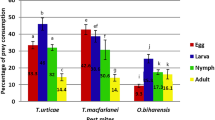Abstract
The study investigated whether honeydew is a source of food or is an arrestant stimulus for adults and 4th instar larvae ofCryptolaemus montrouzieri. Adult predators fed on honeydew but produced few viable eggs. In the presence of honeydew the adult and larvae spent a significantly longer time searching and made more intensive searches on leaf surfaces than on clean parts of the leaf. We concluded that the honeydew was both a food resource and an arrestant.
Résumé
Ce travail a pour but de déterminer si le miellat est une source de nourriture ou un stimulus d'arrêt pour les adultes et les larves de 4° stade deCryptolaemus montrouzieri. Les prédateurs adultes nourris de miellat produisent peu d'œufs viables. L'adulte et la larve de coccinelle font des recherches significativement plus longues et plus intensives sur les surfaces foliaires couvertes de miellat que sur les parties indemnes de miellat. L'étude conclut que le miellat constitue à la fois une source de nourriture et un stimulus d'arrêt.
Similar content being viewed by others
References
Cochran, W. G. &Cox, G. M. — 1957.Experimental design, 2nd edition, Wiley, N. York, 611 p.
Gray, H. E. &Frankel, G. — 1954. The carbohydrate component of Honeydew. —Physiol. Zool., 27, 56–65.
Gray, R. A. — 1954. Composition of honeydew excreted by pineapple mealybugs. —Science N. Y., 115, 129–133.
Hagen, J. S. — 1962. Biology and ecology of predaceous Coccinellidae. —Ann. Rev. Entomol., 7, 289–326.
Heidari, M. &Copland, M. J. W. — 1992. Host finding byCryptolaemus montrouzieri (Col., Coccinellidae) a predator of mealybugs (Hom., Pseudococcidae). —Entomophaga, 37, 621–625.
Hodek, I. — 1957. Influence of temperature, relative humidity and photoperiodicity on the speed of development ofCoccinella septempunctata L. —Acta Soc. entomol. Czechoslov., 55, 121–141.
Johansson, A. S. — 1964. Feeding and nutrition on reproductive processes in insect pp. 43–55.In: Insect reproduction. Symposium N° 2 (Highman K. C. ed.). —R. ent. Soc. London, 120 pp.
Kehat, M. — 1968. The feeding behaviour ofPharoscymmus numidicus (Col.: Coccinellidae). A predator of the date palm scaleParlatoria blanchardi. —Entomol. exp. appl., 11, 30–42.
Murakami, Y. &Tsubaki, Y. — 1984. Searching efficiency of the lady beetleCoccinella septempunctata larvae in uniform and patchy environment. —J. Ethology, 2, 1–6.
Nakamuta, K. — 1982. Switchover in searching behaviour ofCoccinella septempunctata L. (Col.: Coccinellidae) caused by prey consumption. —Appl. Entomol. Zool., 17, 501–506.
Nordlund, D. A. — 1981. Semiochemicals: A review of terminology, pp. 13–25.In: Semiochemicals, their role in pest control. (Nordlund, D. A., Jones, R. L. & Lewis, W. J. eds.) —Wiley, N. York, 306 pp.
Vinson, S. B. — 1968. Source of a substance inHeliothis virescens that elicits a searching response in the habitual parasiteCardiochiles nigriceps. —Ann. ent. Soc. Am., 61, 8–10.
Vinson, S. B. — 1976. Host selection by insect parasitoids. —Ann. Rev. Entomol., 21, 109–123.
Waage, J. K. — 1978. Arrestment responses of the parasitoidNemeritis canescens to a contact chemical produced by its hostPlodia interpunctella. —Physiol. Entomol., 3, 135–146.
Author information
Authors and Affiliations
Rights and permissions
About this article
Cite this article
Heidari, M., Copland, M.J.W. Honeydew: A food resource or arrestant for the mealybug predatorCryptolaemus montrouzieri? . Entomophaga 38, 63–68 (1993). https://doi.org/10.1007/BF02373140
Received:
Accepted:
Issue Date:
DOI: https://doi.org/10.1007/BF02373140




